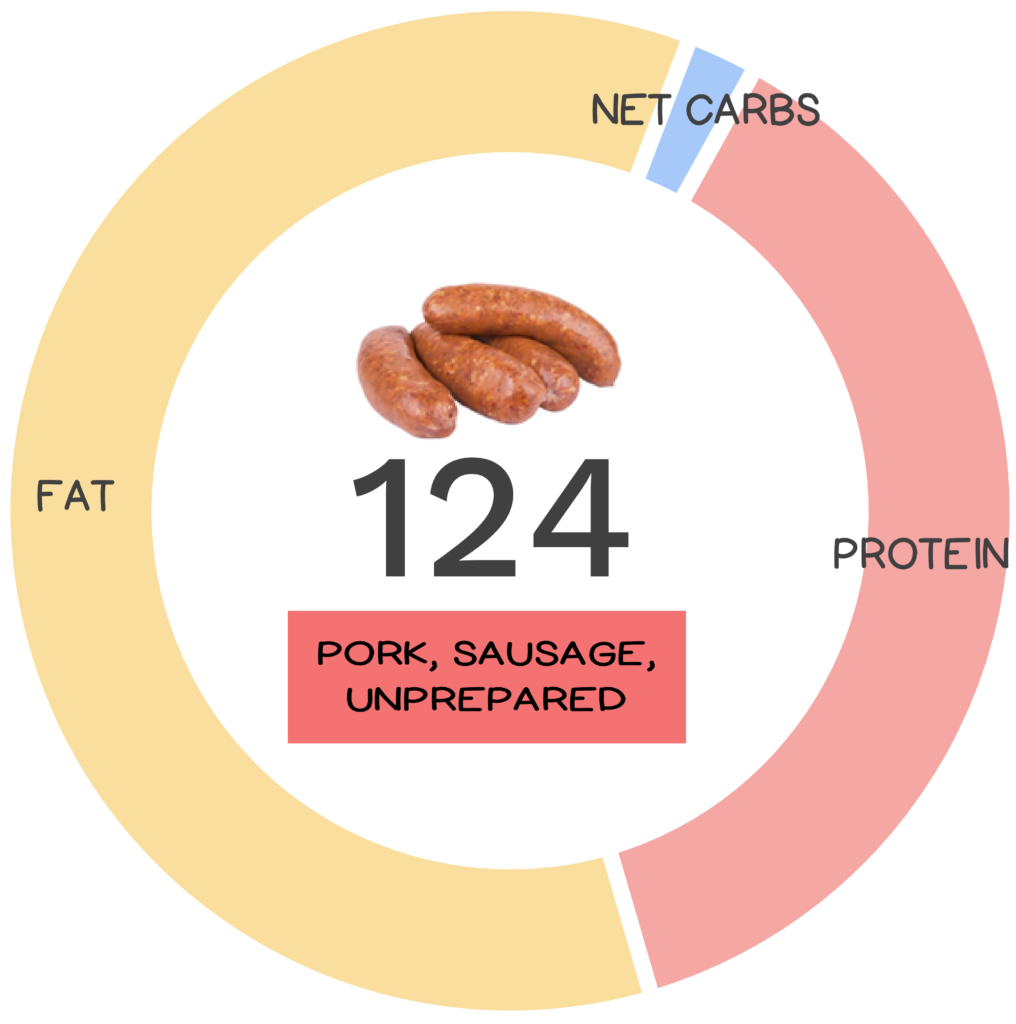
“Pork. The other white meat.” Well, not really! In actuality, the nutritional definition of red meat is any meat that contains more of the iron-rich protein myoglobin than white meat, with white meat defined as any non-dark meat from poultry or fish. Yes, even though you may have heard pork described as “the other white meat”, scientifically speaking it’s really red. This misnomer came from a clever ad campaign in the 1980s designed to associate pork with what consumers considered healthier meats such as chicken and turkey. Guess you could say the slogan is “hogwash”, though for many this misconception prevails to this day!
Pork is the most widely consumed meat in the world, followed by chicken, and beef.
Pork refers to meat from domestic pig, with domestication occurring around 13,000 BC in Mesopotamia. Today, it is the most widely consumed meat in the world, followed by chicken, and beef. In part this can be attributed to its popularity in China, which is responsible for roughly half of all consumption. In fact, in China it’s so important that the country has developed a “strategic pork reserve” to stabilize prices when supplies run low. On the flip side, pork is prohibited in some religions and cultures and is considered a non-kosher food.
Pork is often paired with apples since pigs were historically slaughtered in autumn, which coincided with apple season.
In addition to consuming various cuts of cooked fresh pork in the form of chops, loin, ribs, roast, shoulder, or ground, this meat is also enjoyed cured in various ways, such as bacon, ham, hot dogs, or sausage to name a few. Prior to refrigeration, curing was useful as a means of preserving the meat, but today it is still carried out simply because of the taste. I mean who doesn’t love bacon? And, if you’re wondering why pork is so often paired with apples, there is actually a reason. Before the advent of factory farms, pigs were slaughtered in autumn, after fattening throughout the summer – which just happens to coincide with apple season! (Yum!)
Sausages are one of the oldest forms of processed foods, created out of the need to preserve meat and to efficiently use butchering by-products.
Sausages have been around since ancient times; in fact, they are one of the oldest forms of processed foods. They were created out of the need to preserve meat and as a way of efficiently using up butchering by-products such as meat scraps, offal, blood, and fat, all stuffed into casings. Pork sausages originated in the German city of Frankfurt. German immigrants then brought them to the United States via New York circa the 1860s, where they later became working-class street food, popular because they were convenient and inexpensive. Whether you love them plain, in a bun, or topped with ketchup, mustard, relish, onions, cheese, sauerkraut, chili or anything else you can think of, is likely influenced by where you live, but regardless of how you enjoy them, one thing is for sure, sausages are popular world-wide. It would seem all of us “relish” this food! (Hyuck, see what I did there?)
Nutrivore Score for Pork Sausage – 124
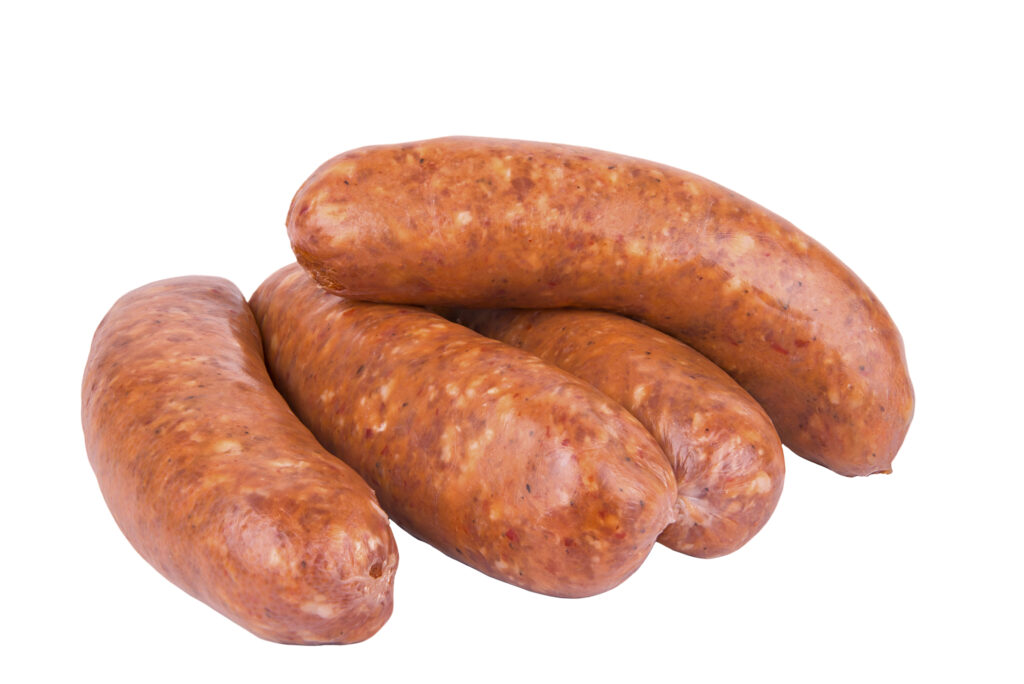
Pork sausage has a Nutrivore Score of 124, making it a low nutrient-dense food! Plus, it is a low-carb food; pork sausage has 0.9 grams of net carbs per 3.5-ounce serving!
Per serving, pork sausage is an excellent source (20-50% daily value) of linoleic acid, monounsaturated fatty acids (MUFA), protein, selenium, vitamin B3 (niacin), and vitamin B12 (cobalamin); and a good source (10-20% daily value) of choline, phosphorus, vitamin B1 (thiamin), vitamin B2 (riboflavin), vitamin B5 (pantothenic acid), vitamin B6 (pyridoxine),and zinc.
Ditch Diets. Embrace Nutrients. Start with this FREE Guide.
Sign up for the free Nutrivore Newsletter, your weekly, science-backed guide to improving health through nutrient-rich foods — without dieting harder —and get the Beginner’s Guide to Nutrivore delivered straight to your inbox!

Pork Sausage Nutrition Facts
One serving of pork sausage is standardized to 100 grams (3.5 ounces). When you cook pork sausage, it reduces in volume by approximately 10 to 35%, depending on how they are cooked: 100 grams of unprepared pork sausage is equivalent to 87 grams of pan-fried pork sausage or 65 grams of microwaved pork sausage.
Pork Sausage Nutrition Facts Per Serving
| Pork sausage, unprepared | Nutrivore Score: 124 | Nutrient Density: Low |
|---|---|---|
| Serving Size: 3.5 ounces (100 grams) | Protein: 15.4 grams | Net Carbohydrates: 0.9 grams |
| Calories: 288 | Total Fat: 24.8 grams | Dietary Fiber: 0.0 grams |
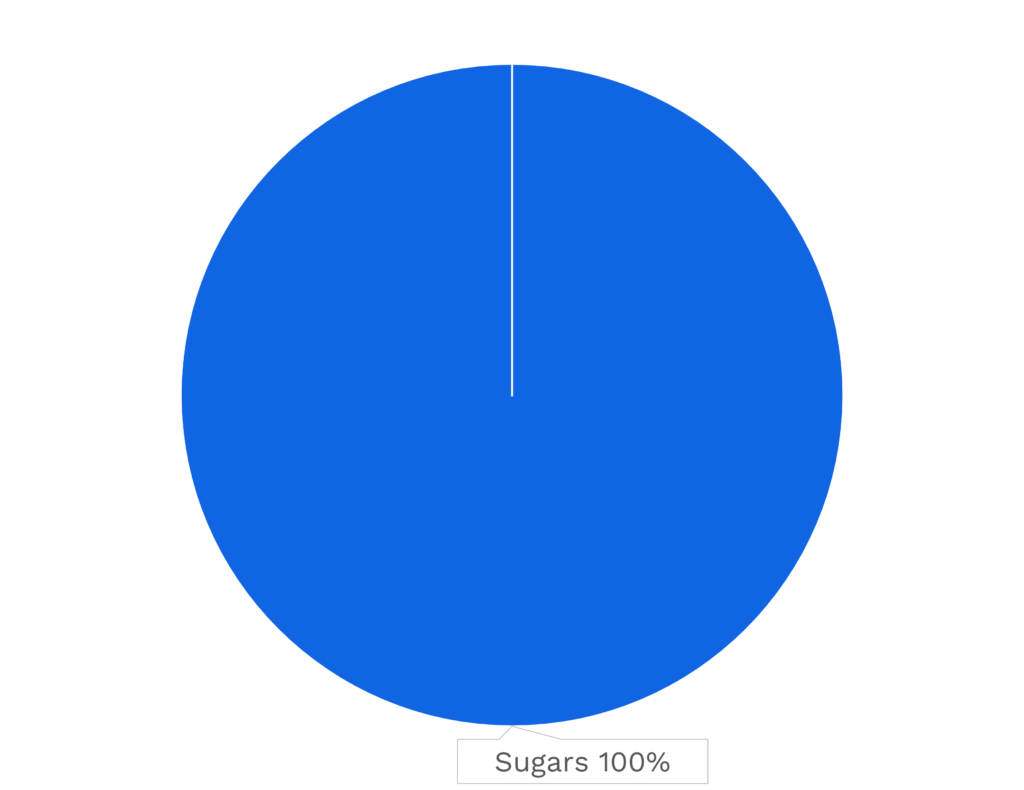
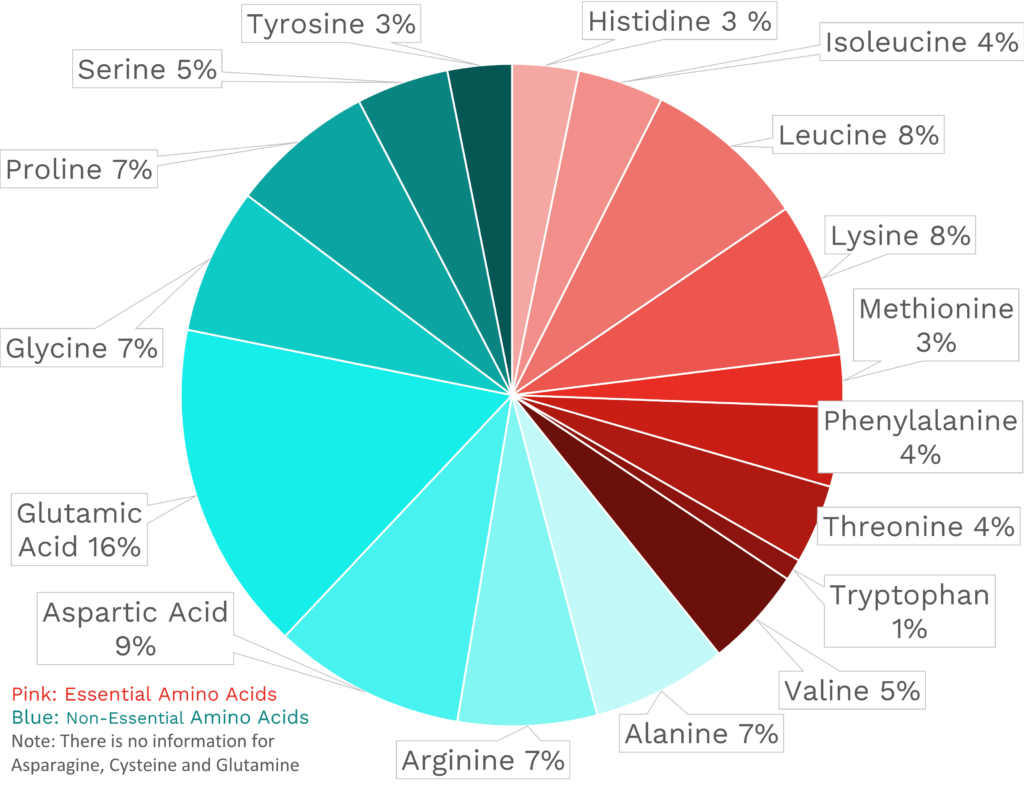
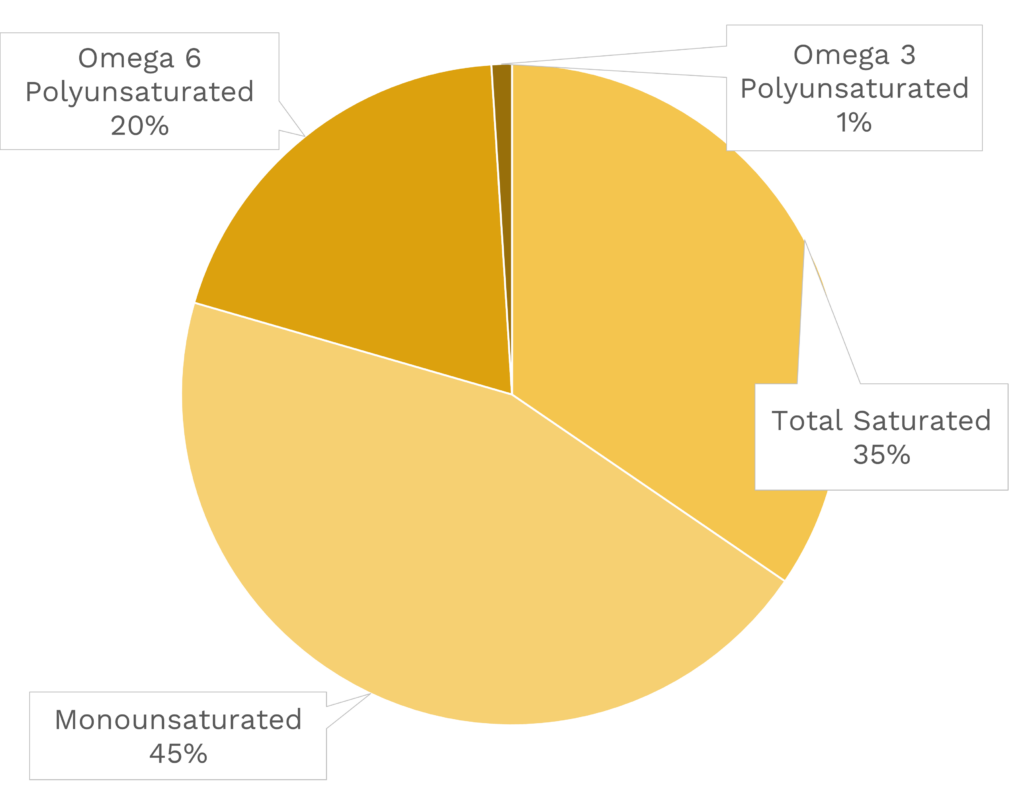
| VITAMINS | ||
|---|---|---|
| Vitamin A | 27.0 μg RAE | 3% DV |
| Vitamin B1 (Thiamin) | 223.0 μg | 19% DV |
| Vitamin B2 (Riboflavin) | 147.0 μg | 11% DV |
| Vitamin B3 (Niacin) | 5.4 mg | 34% DV |
| Vitamin B5 (Pantothenic Acid) | 0.7 mg | 14% DV |
| Vitamin B6 (Pyridoxine) | 174.0 μg | 10% DV |
| Vitamin B7 (Biotin) | ~ | ~ |
| Vitamin B9 (Folate) | 2.0 μg | 1% DV |
| Vitamin B12 (Cobalamin) | 0.9 μg | 38% DV |
| Vitamin C | 0.0 mg | 0% DV |
| Vitamin D (D2 + D3) | 1.4 μg | 7% DV |
| Vitamin E | 1.2 mg | 8% DV |
| Vitamin K | 0.3 μg | 0% DV |
| Choline | 52.5 mg | 10% DV |
| Myo-Inositol | ~ | ~ |
| CoQ10 | ~ | ~ |
| FUNCTIONAL FATS | ||
|---|---|---|
| MUFA | 9.8 g | 49% DV |
| ALA | 129.0 mg | 8% DV |
| EPA + DHA | 5.0 mg | 2% DV |
| CLA | 29.0 mg | ~ |
| Linoleic Acid | 3.9 g | 23% DV |
| MCT’s | 0.0 g | ~ |
| MINERALS | ||
|---|---|---|
| Calcium | 8.0 mg | 1% DV |
| Copper | 57.0 μg | 6% DV |
| Iodine | ~ | ~ |
| Iron | 1.0 mg | 6% DV |
| Magnesium | 15.0 mg | 4% DV |
| Manganese | 17.0 μg | 1% DV |
| Phosphorus | 133.0 mg | 11% DV |
| Potassium | 307.0 mg | 7% DV |
| Selenium | 17.8 μg | 32% DV |
| Sodium | 739.0 mg | 32% DV |
| Zinc | 2.0 mg | 18% DV |
| PHYTONUTRIENTS | ||
|---|---|---|
| Carotenoids | 0.0 μg | ~ |
| Polyphenols | 0.0 mg | ~ |
| Phytosterols | 0.0 mg | ~ |
| Glucosinolates | ~ | ~ |
| Thiosulfinates | ~ | ~ |
| Betalains | ~ | ~ |
| AMINO ACIDS & PEPTIDES | ||
|---|---|---|
| Taurine | ~ | ~ |
| Ergothioneine | ~ | ~ |
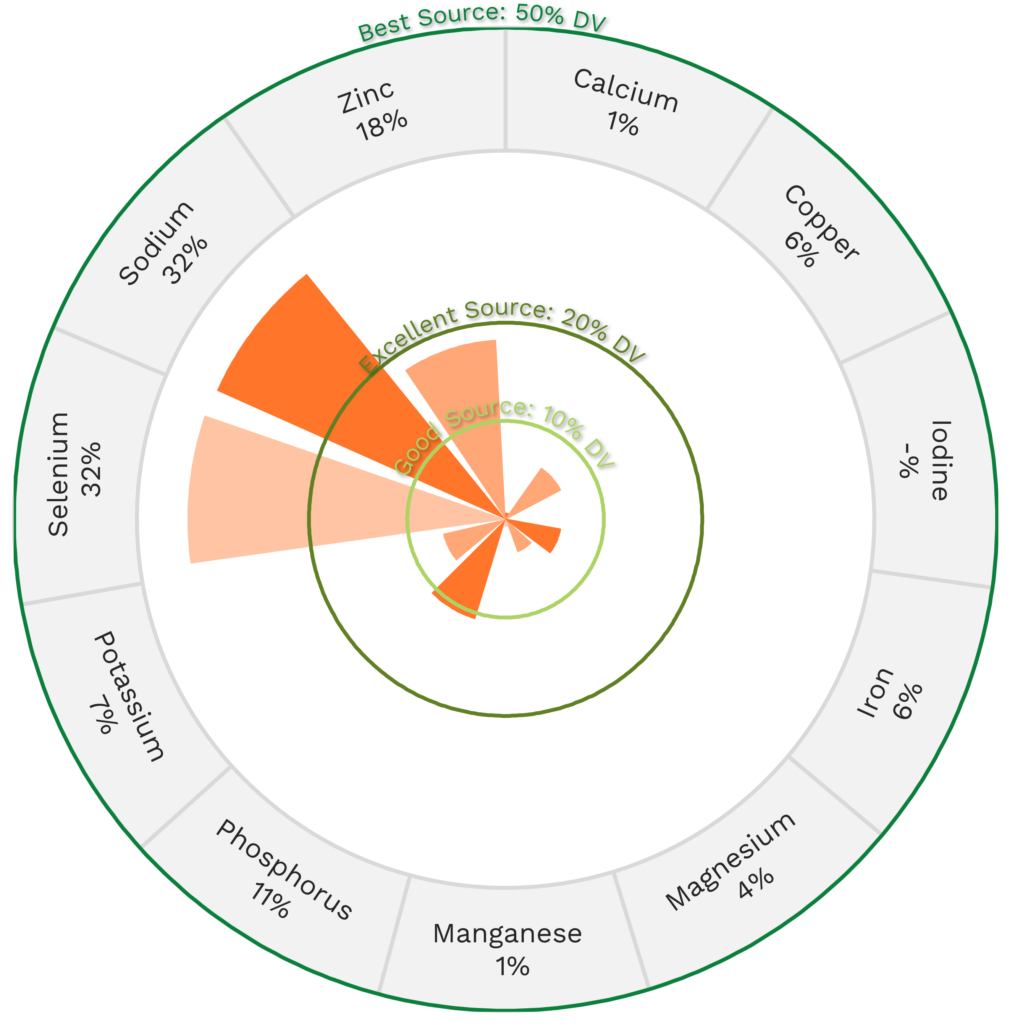

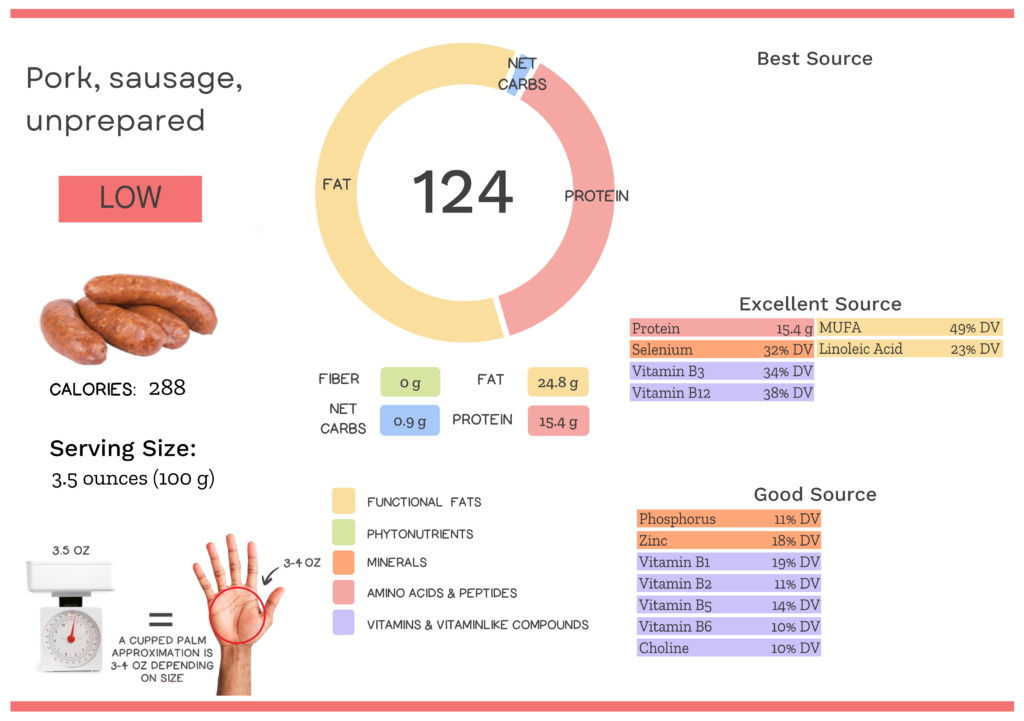

Quality Meat and Seafood
- 100% grass-fed and finished beef, bison and lamb
- 100% pasture-raised pork, chicken, duck and turkey
- Wild-caught seafood
- Raised on regenerative family farms
- Fast delivery from our farms to your door
Pork Sausage Nutrition Varies With Cooking
Pork sausages are a popular food that can be prepared in numerous ways, resulting in different flavors and Nutrivore Scores.
| NUTRIVORE SCORE | |
|---|---|
| Pork sausage, link/patty, cooked, pan-fried | 124 |
| Pork sausage, link/patty, fully cooked, microwaved | 96 |
| Pork sausage, link/patty, fully cooked, unheated | 99 |
| Pork sausage, link/patty, unprepared | 124 |
Sausage Nutrition Varies With Type
Sausages are popular all over the world, with most countries having their own special version of this food. Sausages can be prepared from many different types of meat, which impacts their taste, texture, and Nutrivore Score.
| NUTRIVORE SCORE | |
|---|---|
| Beef sausage, breakfast sausage, pre-cooked, unprepared | 94 |
| Beef sausage, honey roll | 1931 |
| Berliner sausage, pork, beef | 167 |
| Blood sausage | 87 |
| Braunschweiger (liver sausage), pork | 621 |
| Chorizo sausage, pork, link or ground, raw | 140 |
| Italian sausage, pork, mild, raw | 127 |
| Italian sausage, sweet, links | 1461 |
| Liver sausage, liverwurst, pork | 6231 |
| Polish sausage, beef with chicken, hot | 1182 |
| Polish sausage, pork | 1101 |
| Polish sausage, pork and beef, smoked | 1121 |
| Pork sausage, link/patty, unprepared | 124 |
| Pork sausage, smoked link | 104 |
| Sausage, chicken, beef, pork, skinless, smoked | 1501 |
| Sausage, meatless | 282 |
| Sausage, New England brand, pork, beef | 2161 |
| Sausage, pork and beef, smoked link | 84 |
| Sausage, pork and beef, with cheddar cheese, smoked | 1181 |
| Sausage, pork and turkey, pre-cooked | 831 |
| Thuringer, cervelat, summer sausage, beef, pork | 160 |
| Turkey sausage, breakfast links, mild, raw | 186 |
| Turkey sausage, fresh, raw | 1961 |
| Turkey sausage, hot, smoked | 220 |
| Turkey sausage, Italian, smoked | 2271 |
| Vienna sausage, chicken, beef, pork, canned | 110 |
Did you relish learning about the nutrients in pork sausage? Maybe your friends will too!
Health Benefits of Pork Sausage Nutrients
Let’s take a closer look at all of the best and excellent source of nutrients found in a 3.5-ounce serving of pork sausage and see how they benefit our health.
Pork Sausage Provides 49% DV Monounsaturated Fatty Acids (MUFA)
Pork sausage is an excellent source of monounsaturated fatty acids (MUFA), providing 49% of the daily value per 3.5-ounce serving! Note that pork sausages are not associated with cardiovascular health benefits like other sources of monounsaturated fats, however.
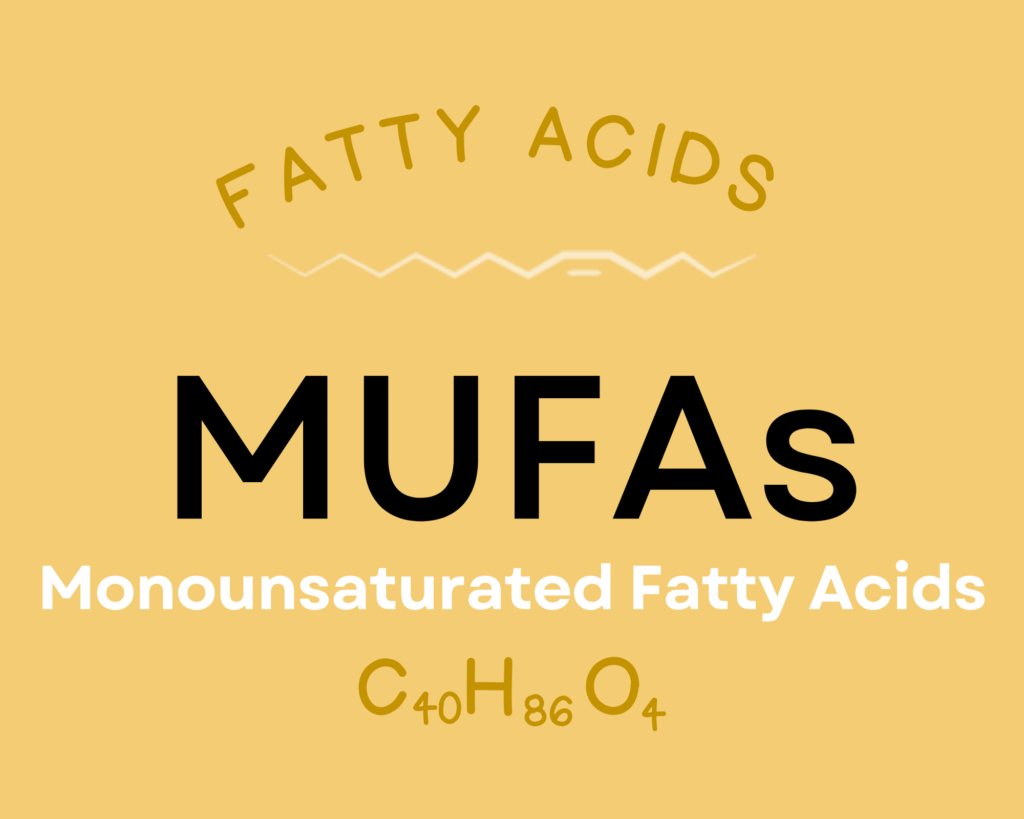
Monounsaturated fatty acids (MUFA), the most abundant of which is oleic acid, play an important role in cellular function due to its presence in phospholipids in cell membranes. Oleic acid is beneficial for cardiovascular health—both in reducing risk factors like high blood pressure, cholesterol, triglycerides, inflammation, and oxidative stress, and in reducing actual cardiovascular disease incidence and events. Oleic acid has even demonstrated anti-cancer activity, with an ability to inhibit the progression, proliferation, and metastasis of several types of cancer cells. Research shows this fat could benefit body weight regulation and obesity through its effects on energy metabolism and lipogenesis. In fact, human trials show that enriching diets with oleic acid leads to decreases in central obesity, abdominal fat, body weight, and food intake, while also possibly increasing energy expenditure! Oleic acid also possesses some benefits for diabetics—influencing genes and pathways involved in insulin signaling and glucose metabolism, as well as helping protect against some complications of diabetes, like diabetic retinopathy and atherosclerosis. Learn more about oleic acid here.
Pork Sausage Provides 38% DV Vitamin B12 (Cobalamin)
Pork sausage is also an excellent source of vitamin B12 (cobalamin), providing 38% of the daily value per 3.5-ounce serving!

Vitamin B12 (cobalamin) is a water-soluble vitamin that serves as a cofactor for enzymes involved in energy metabolism, red blood cell production, DNA synthesis, neurotransmitter production, nervous system health, and folate metabolism. As a result of these roles, vitamin B12 is vital for maintaining brain and nervous system health, and may have a protective effect against dementia, Alzheimer’s disease, and depression. There’s also some evidence vitamin B12 may be cancer-protective, possibly through supporting folate metabolism (which then assists in repairing DNA damage). Learn more about vitamin B12 here.
Pork Sausage Provides 34% DV Vitamin B3 (Niacin)
Pork sausage is an excellent source of vitamin B3 (niacin), providing 34% of the daily value per 3.5-ounce serving!

Niacin is a water-soluble B complex vitamin (vitamin B3) that’s needed to produce two very important coenzymes: nicotinamide adenine dinucleotide (NAD) and nicotinamide adenine dinucleotide phosphate (NADP). NAD and NADP are needed for over 400 enzymes involved in DNA repair, fatty acid synthesis, antioxidant systems, detoxification, and hormone synthesis, as well as the breakdown of fat, carbohydrate, protein, and alcohol. Niacin has therapeutic potential for cardiovascular disease and hyperlipidemia, and may also be protective against cancer and type 1 diabetes. Some research suggests it could benefit health outcomes for patients with HIV or schizophrenia as well. Learn more about niacin here.
Pork Sausage Provides 32% DV Selenium
Pork sausage is also an excellent source of selenium, providing 32% of the daily value per 3.5-ounce serving!

Selenium is a trace mineral needed by all mammals to sustain life. It serves as a component of the non-proteinogenic amino acids selenocysteine and selenomethionine, and also helps form over two dozen selenoproteins involved in reproduction, thyroid hormone metabolism, antioxidant defense, DNA synthesis, and immunity. Observational research suggests selenium could play a protective role against cancer, heart disease, asthma, and inflammatory bowel disease, although human trials have generally been lacking or contradictory. There’s also evidence that selenium can play a preventative role in asthma and inflammatory bowel disease, while also reducing mortality in patients with sepsis. Learn more about selenium here.
Pork Sausage Provides 15.4 g of Protein
Pork sausage is an excellent source of protein, providing 15.4 g of protein per 3.5-ounce serving!
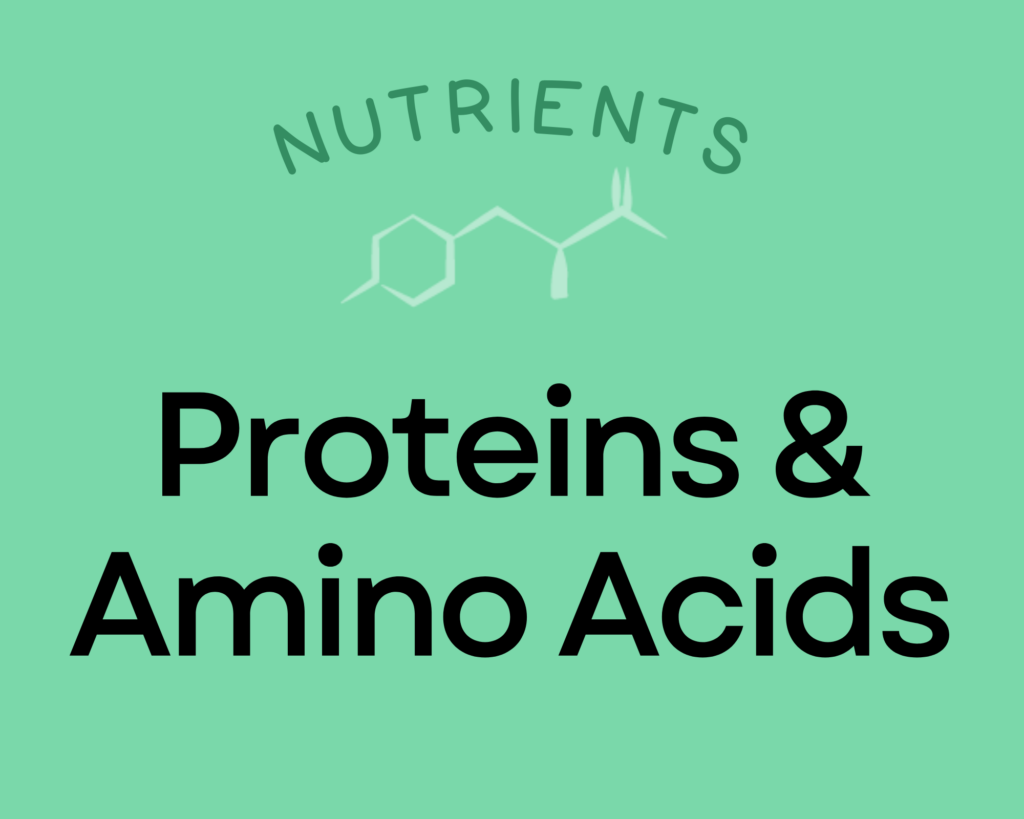
Proteins are the molecules that actually perform most of the various functions of life. In addition to being major structural components of cells and tissues, they have incredibly diverse roles from driving chemical reactions (e.g., enzymes) to signaling (e.g., some types of hormones) to transporting and storing nutrients. Dietary protein is necessary to supply the amino acid building blocks for all of the proteins in our bodies. The recommended daily allowance of protein is 0.36 grams per pound body weight (0.8 grams per kilogram of body weight). That amounts to 56 grams for a 150-pound person. However, it’s important to emphasize that this number is considered a minimum daily allotment, and there is no established upper limit. In fact, many studies have evaluated diets containing three to four times more protein than this minimum and proven benefits to weight management, body composition, hormone regulation, and cardiovascular health. These studies suggest that an optimal protein intake for most people is probably in the range of 1.2 to 1.8 grams per kilogram bodyweight (82 to 122 grams for that same 150-pound person), and that people who are very active may see the best results at even higher intake. Learn more about protein and amino acids here.
Pork Sausage Provides 23% DV Linoleic Acid
Pork sausage is also an excellent source of linoleic acid, providing 23% of the daily value per 3.5-ounce serving!
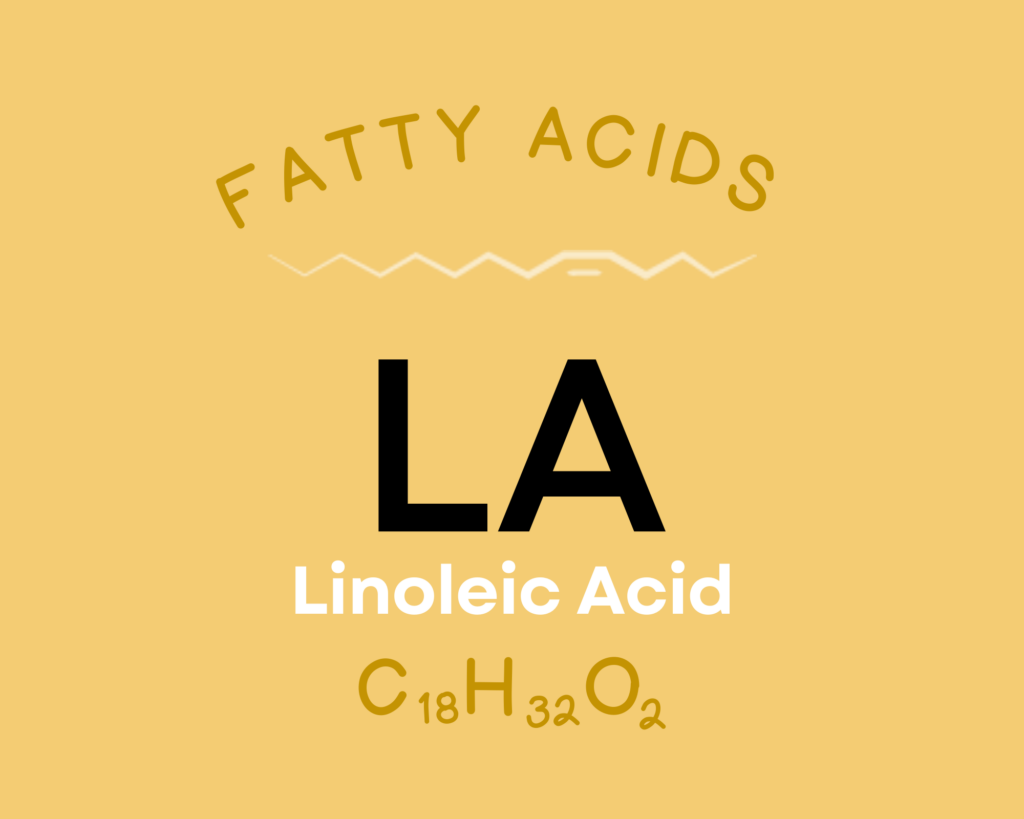
Linoleic acid is the only essential omega-6 fatty acid. Along with being required for human growth and development, it serves as a structural component of cell membranes, plays a role in maintaining skin health and integrity, and is a precursor for bioactive lipid mediators. Although linoleic acid can lower LDL cholesterol levels, research hasn’t consistently shown any protective effect against heart disease. Likewise, there’s mixed evidence (some showing benefit, some showing harm) for the effects of linoleic acid on cancer. Higher intakes have also been associated with depression and obesity, although it may have a protective effect against diabetes. Learn more here.
Learn What Foods Are the Best Sources of Every Nutrient

The Top 25 Foods for Every Nutrient
The Top 25 Foods for Every Nutrient e-book is a well-organized, easy-to-use, grocery store-friendly guide to help you choose foods that fit your needs of 43 important nutrients while creating a balanced nutrient-dense diet.
Get two “Top 25” food lists for each nutrient, plus you’ll find RDA charts for everyone, informative visuals, fun facts, serving sizes and the 58 foods that are Nutrient Super Stars!
Buy now for instant digital access.
How Much Pork Sausage Should We Eat Per Day?
If we’re being “frank”, it’s clear that sausages are definitely in the category of a sometimes food when it comes to our diet, but it’s also important to remember that they are a good source of protein and do provide some functional fats, minerals, and vitamins as well.
Processed meats encompass a range of meat products that undergo preservation methods like smoking, curing, salting, or the addition of preservatives. Common examples include ham, pastrami, salami, sausages, bacon, and hot dogs. These processes extend the shelf life of the meat products and enhance their flavor.
Numerous observational studies have linked high consumption of processed meat to an increased risk of cancer—particularly colon, breast, liver, and lung cancers—cardiovascular disease and type 2 diabetes. The associations between processed meat and cancer or cardiovascular disease may be an example of what’s called the healthy user bias. The idea is that people who eat less processed meat also have a lot of other health-promoting behaviors, like eating more vegetables, not smoking, and being physically active. Because processed meat has been demonized for so long, people who make a lot of day-to-day choices geared at improving their long-term health, tend not to eat very much of it. While studies perform advanced statistical analyses to try to account for as many of these other factors as possible, there’s typically a residual effect—it’s impossible to account for every confounding variable.
While more studies are needed to understand the link between processed meat consumption and health, the current state of evidence is that it’s best to eat processed meat in moderation. A 2011 study makes a compelling case for staying below 50 grams (1 3/4 ounces) daily.
Easily track your servings of Nutrivore Foundational Foods!

The Nutrivore Weekly Serving Matrix
The Nutrivore Weekly Serving Matrix digital resource is an easy-to-use and flexible weekly checklist designed to help you maximize nutrient-density and meet serving suggestions of Nutrivore foundational foods, all without having to weigh or measure your foods!
Includes a 22-page instructional guide and downloadable interactive guides.
Buy now for instant digital access.
cITATIONS
Expand to see all scientific references for this article.
USDA Food Central Database: Pork sausage, link/patty, unprepared


